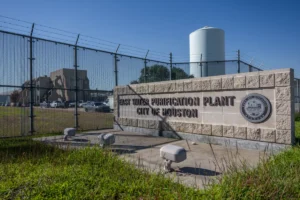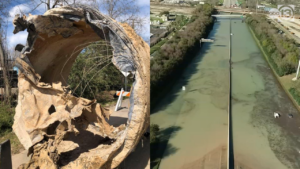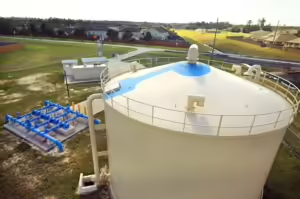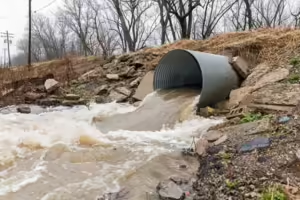Water is essential for life and prosperity, yet Greater Houston faces a growing crisis that threatens both. Beneath the surface of one of the nation’s most dynamic regions lies a fragile and aging water infrastructure system that is increasingly incapable of meeting today’s demands. From deteriorating pipes and outdated treatment facilities to the pressures of a growing population, Houston’s water challenges require immediate action. Without strategic investments and innovative solutions, the consequences could ripple far beyond our region.
A System Under Stress
 Much of Houston’s water infrastructure was designed and constructed decades ago, with many pipelines and treatment plants nearing or exceeding their intended lifespan. Corroded pipes, cracks, and leaks lead to significant water loss—up to 15% of treated water is estimated to leak out of the system before reaching end-users. These inefficiencies not only waste resources but also increase costs for residents and businesses.
Much of Houston’s water infrastructure was designed and constructed decades ago, with many pipelines and treatment plants nearing or exceeding their intended lifespan. Corroded pipes, cracks, and leaks lead to significant water loss—up to 15% of treated water is estimated to leak out of the system before reaching end-users. These inefficiencies not only waste resources but also increase costs for residents and businesses.
Nowhere is this more evident than at Houston’s East Water Purification Plant. As one of the city’s primary facilities responsible for treating millions of gallons of water daily, the plant is aging rapidly and facing significant operational challenges. Deterioration of critical components has led to increased maintenance demands, inefficiencies in water processing, and heightened risks of service disruptions. The plant, which has served the city for decades, was not designed to handle the scale or complexities of modern water needs. Its inability to meet the region’s growing demands further highlights the urgency for infrastructure upgrades.
Lessons from the Past
Houston’s history provides stark reminders of the consequences of underinvesting in critical infrastructure, particularly water systems. Over the past several years, the city has experienced a series of high-profile water line and main breaks, each highlighting the fragility of the aging system.
 One of the most significant incidents occurred in February 2020, when a 96-inch water main ruptured on the East Loop near Clinton Drive. The break flooded roadways, caused widespread water outages, and prompted a citywide boil water notice. Schools and businesses were forced to close, and emergency services scrambled to respond to the crisis. The event disrupted the lives of millions and underscored the urgent need for proactive maintenance and modernization.
One of the most significant incidents occurred in February 2020, when a 96-inch water main ruptured on the East Loop near Clinton Drive. The break flooded roadways, caused widespread water outages, and prompted a citywide boil water notice. Schools and businesses were forced to close, and emergency services scrambled to respond to the crisis. The event disrupted the lives of millions and underscored the urgent need for proactive maintenance and modernization.
During extreme weather events, such as the 2021 winter storm, the city faced additional challenges. Freezing temperatures caused numerous water main breaks across Houston, leaving many residents without water for days. The storm also exposed vulnerabilities at facilities like the East Water Purification Plant, which struggled to maintain operations during the prolonged freeze.
These recurring crises illustrate the high costs—both economic and social—of deferred maintenance and lack of resilience planning. They serve as a warning that Houston cannot afford to wait until the next failure to take action.
A Lesson for Municipal Utility Districts
The challenges Houston faces are not limited to urban systems; they hold valuable lessons for the region’s Municipal Utility Districts (MUDs). These entities, which serve millions of residents in suburban and unincorporated areas, play a critical role in water delivery and wastewater management.
 Deferred maintenance can lead to cascading failures for MUDs, just as it has for Houston’s infrastructure. Aging pipes, treatment facilities, and storage tanks within these districts require regular inspection, repair, and replacement to avoid costly and disruptive failures. MUDs that delay investments in maintaining their systems risk encountering the same widespread water line breaks and boil water notices that Houston has faced in recent years.
Deferred maintenance can lead to cascading failures for MUDs, just as it has for Houston’s infrastructure. Aging pipes, treatment facilities, and storage tanks within these districts require regular inspection, repair, and replacement to avoid costly and disruptive failures. MUDs that delay investments in maintaining their systems risk encountering the same widespread water line breaks and boil water notices that Houston has faced in recent years.
For MUDs, proactive infrastructure management is not just a best practice—it’s a necessity. Regularly scheduled repairs, coupled with strategic upgrades, ensure the continued reliability of water services and help manage long-term costs. While it may be tempting to defer maintenance to keep short-term expenses low, the long-term risks—higher costs, service disruptions, and diminished public trust—far outweigh the savings.
By taking a preventative approach, MUDs can strengthen their systems and enhance resilience. Collaboration with regional entities, including Harris County and the Texas Water Development Board, can provide access to funding and expertise to support these efforts.
Why Investment Matters Now
The current challenges present an opportunity for transformative investment in Houston’s water infrastructure. Federal funding, such as the Infrastructure Investment and Jobs Act (IIJA) and the Water Infrastructure Finance and Innovation Act (WIFIA), provides unprecedented resources for water projects. State initiatives, like the Texas Water Development Board’s programs, offer additional pathways for funding.
Local governments and private entities also have a crucial role to play. Public-private partnerships can bridge funding gaps and ensure that projects move forward efficiently. Bonds and utility fee adjustments, though politically challenging, are proven tools for generating long-term funding for essential projects.
Investments in water infrastructure go beyond merely replacing old pipes or repairing treatment facilities. Upgraded systems can significantly reduce water loss, improve service reliability, and ensure that the region remains competitive. Moreover, a resilient water infrastructure system helps prevent cascading failures during disasters, saving billions of dollars in potential damages and recovery costs.
A Vision for the Future
Preventing a water crisis will require more than investment—it demands forward-thinking solutions that embrace technology and sustainability. Advanced metering infrastructure (AMI) can help utilities detect and address leaks in real time, saving millions of gallons annually. Smart treatment systems equipped with artificial intelligence can optimize operations, reducing energy use and costs while improving water quality.
Sustainability must also be at the forefront. Water reuse systems, where treated wastewater is recycled for industrial use or irrigation, can reduce pressure on freshwater supplies. Stormwater harvesting, a practice that collects and treats rainwater for non-potable uses, offers a complementary solution to address both water scarcity and urban flooding.
The Houston region has the opportunity to learn from other cities that have successfully modernized their water systems. San Antonio, for example, has become a national leader in water conservation and reuse, achieving long-term sustainability through aggressive investment and public education. Similarly, Las Vegas has implemented stringent water conservation programs that ensure no drop of treated water goes to waste. These models provide valuable lessons that can be adapted to Houston’s unique challenges.
Broader Impacts
 The stakes go far beyond water infrastructure. Reliable access to clean water is essential for public health, economic growth, and environmental sustainability. Without it, Houston risks losing its competitive edge as a hub for business and innovation. Developers and businesses are less likely to invest in areas where water reliability is in question, potentially slowing the region’s economic growth.
The stakes go far beyond water infrastructure. Reliable access to clean water is essential for public health, economic growth, and environmental sustainability. Without it, Houston risks losing its competitive edge as a hub for business and innovation. Developers and businesses are less likely to invest in areas where water reliability is in question, potentially slowing the region’s economic growth.
Furthermore, the impacts of climate change, including more severe droughts and flooding, compound the urgency. Building resilience into our water infrastructure is not just a necessity for today but an investment in the future. By planning now, we can ensure that Houston is prepared for the challenges ahead, safeguarding the health, prosperity, and quality of life for millions of residents.
A Call to Action
The West Houston Association is committed to fostering collaboration among developers, civic leaders, policymakers, and community stakeholders to tackle these challenges. Together, we must prioritize water infrastructure as a cornerstone of regional resilience and prosperity.
This is a defining moment for Greater Houston. We have the resources, the knowledge, and the opportunity to turn a looming crisis into a success story. Let’s work together to ensure that the water we rely on today continues to flow for generations to come.
The WHA Water Resources Committee encourages you to attend Wasted Water: The Aging Infrastructure Dilemma on February 6, 2025 to further explore the urgent need for investment and innovation in water infrastructure. The event will discuss lessons learned, funding opportunities, and practical, forward-thinking solutions to prevent a looming water crisis for our region.
